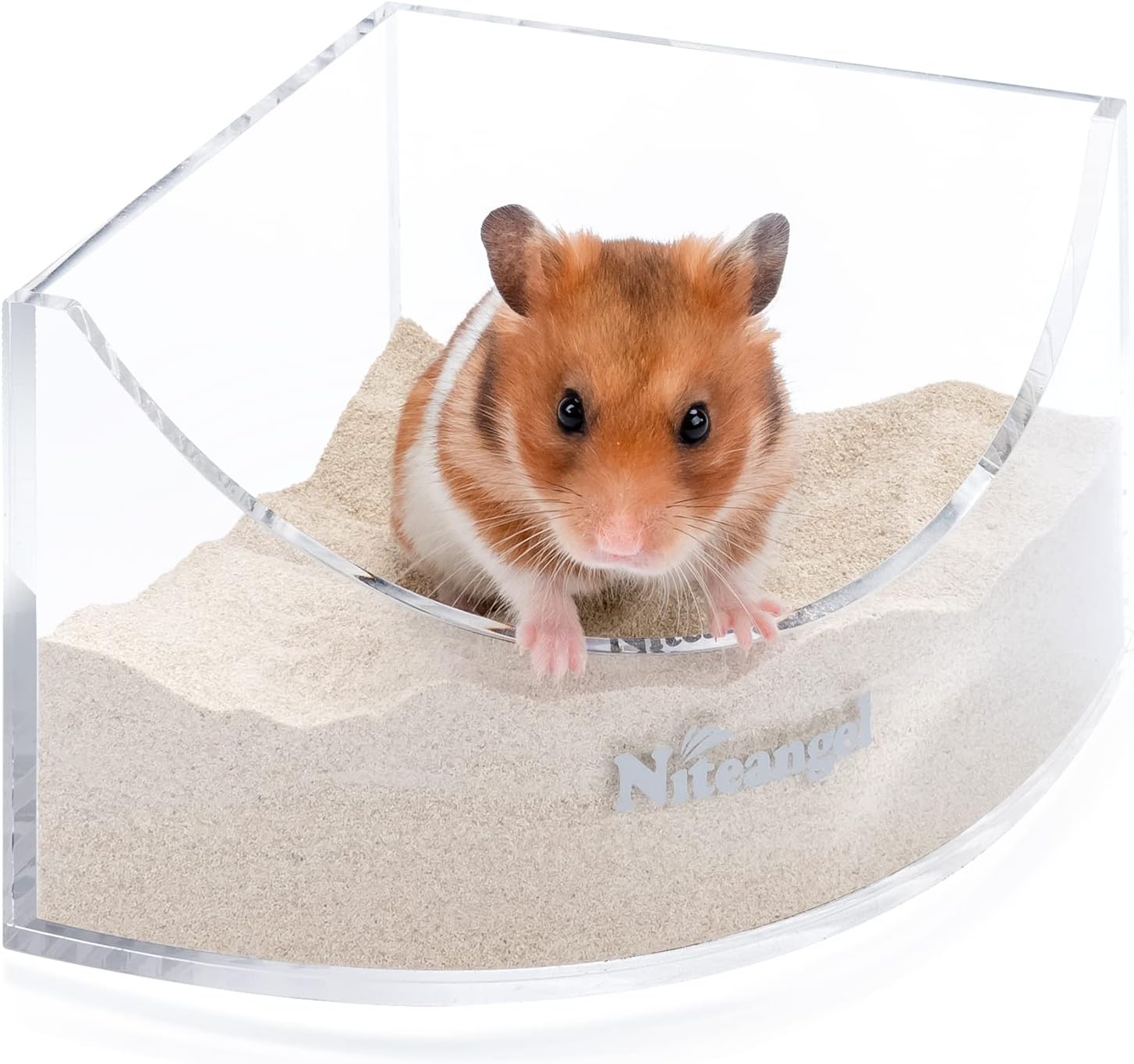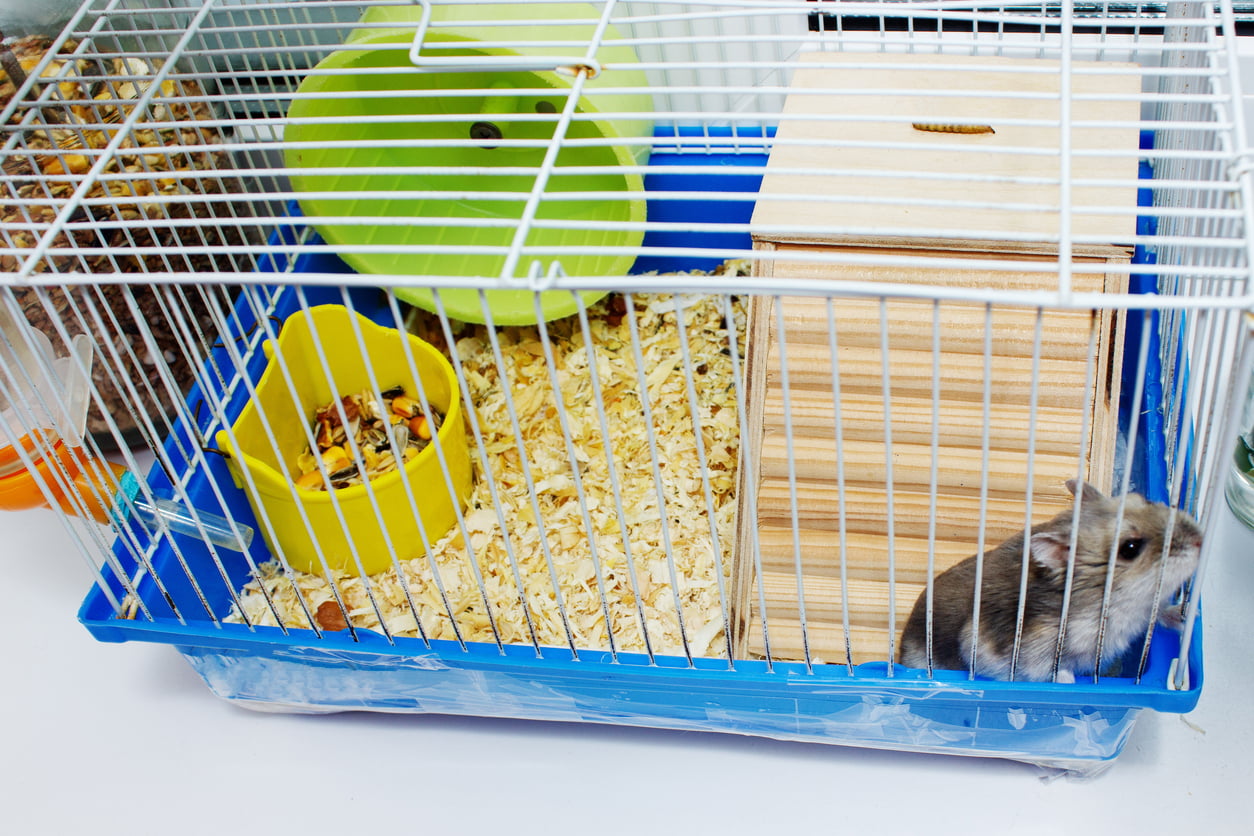Is it safe to bathe a hamster? The answer is a resounding no, as water baths can strip their fur of natural oils and cause stress. This article takes you through safer cleaning habits for your hamster, outlining why sand baths are the way to go and how to maintain proper hamster hygiene without risking their well-being. Can you bathe a hamster in a different way? Explore the right practices to ensure your hamster stays clean and healthy.
Key Takeaways
- Hamsters are self-grooming animals; water baths can strip away natural oils and cause stress and skin problems. Providing dust baths is a safer option to keep them clean.
- Regularly cleaning your hamster’s cage and avoiding full water baths unless absolutely necessary are key to maintaining your pet’s health.
- In addition to sand baths, other grooming needs include gentle brushing and occasional trims, especially for long-haired breeds. Professional grooming may be required for more severe conditions.
Understanding Hamster Hygiene: The Basics

Did you know that hamsters, including dwarf hamsters, are naturally tidy creatures? Yes, these petite pets have quite the grooming routine and spend a significant part of their day cleaning themselves to maintain their shiny fur. However, there’s a caveat – if your hamster, be it a dwarf or any other breed, slacks on its hygiene, it could end up with serious health issues, like:
- the dreaded wet tail
- matted fur
- skin infections
- parasites
As a responsible pet parent, it’s important to keep an eye on your hamster’s grooming habits and take action if you notice any signs of poor hygiene. Regularly cleaning their cage and providing them with a dust bath can help maintain their cleanliness and overall health.
So, what’s the secret behind a hamster’s clean and shiny coat? It’s not water baths, as many hamsters’ parents might assume. The secret lies in the natural oils in their fur and, believe it or not, dust baths. These dust, or rather, sand baths, play a vital role in maintaining the cleanliness of a hamster’s fur.
The Truth About Water Baths for Hamsters
If you have been bathing your hamster in water, it’s time to reconsider! Here’s why: Hamsters have natural oils in their fur that keep it clean, shiny, and healthy. When you give a hamster a water bath, these natural oils get washed away, leading to dry, irritated skin and a very unhappy hamster.
Water baths can also significantly stress out your tiny friend. Hamsters are not natural swimmers, and being submerged in water can be quite traumatic for them. Instead, giving your hamster a bath using an occasional sand bath is a much more natural and less stressful grooming method for your hamster.
But remember, water baths are not entirely off the table. There are specific situations, such as when your hamster has come in contact with a toxic substance or has been in a warm room, where a water bath might be necessary.
Why Water is Not a Hamster’s Friend
Although water is the lifeblood of many species, it’s not a hamster’s best friend when it comes to grooming. The reason water is bad for a hamster’s fur and skin lies in the essential oils present in their fur. These oils are crucial for skin health and protection against different conditions. When these oils are stripped away due to a water bath, it can lead to various skin issues such as:
- dermatitis
- mite infestations
- mange
- symptoms like fur loss, dry, scaly skin, itching, and redness.
Additionally, the stress caused by the sudden change in their skin can lead to respiratory problems and liver damage.
Signs Your Hamster Might Need a Bath
Although water baths are typically not advisable for hamsters, there are scenarios that warrant an exception. But how can you tell when your hamster might need a special bath? Look out for signs like:
- hair loss
- lethargy
- difficulty breathing
- other persistent symptoms
These could indicate a skin problem that might necessitate a special bath.
If your hamster has a skin condition like mites or ringworm, a medicated bath might be in order. In cases where your hamster gets something sticky or toxic stuck in their fur, a water bath becomes absolutely necessary. Remember, only resort to water baths when it’s truly needed, and always ensure the bathing environment is warm and stress-free for your hamster.
The Ideal Way to Clean Your Hamster: Sand Baths

Now that we’ve established that water baths are not the best for your hamster, you might be wondering what is. The answer is sand baths! Hamsters absolutely love sand baths. Not only do they enjoy rolling in the sand, but it also helps them exfoliate their coat, soaking up oils and maintaining healthy skin.
However, it involves more than just placing some sand in a bowl. The type of sand you use matters. Always opt for a dedicated sand that is mineral-free and undyed. Avoid dust or powder, as they can cause respiratory issues. Ideally, your hamster should enjoy a sand bath two to three times a week.
Selecting the Right Sand for Your Hamster’s Bath
Selecting the appropriate sand for your hamster’s bath is of utmost importance. Play sand that’s been washed and dried is an excellent choice. It’s typically used in children’s sandboxes and is quite affordable. However, be wary of chinchilla dust or any sand that can potentially harm your hamster’s respiratory system.
Ensuring that the sand is clean and safe for your hamster is paramount. Avoid anything labeled as ‘dust’ or ‘powder,’ as these fine particles can interfere with your hamster’s breathing. Go for plain reptile sand without any added calcium or dyes, and you’re all set. I would recommend going with the Niteangel Hamster Bath Sand, as it is the top-rated hamster bathing sand on Amazon.
How to Introduce Your Hamster to Sand Bathing
Introducing your hamster to sand bathing is simpler than you might think. All you need is a sturdy, chew-proof container filled with 1-2 inches of hamster-friendly bathing sand placed in your pet’s habitat.
As for the frequency of sand baths, aim for a few times per week. This will keep their fur clean and their skin healthy without causing any stress or discomfort. Remember, your hamster’s comfort should always be the top priority!
Maintaining a Clean Habitat for Your Furry Friend

While sand baths play a large role in hamster hygiene, they don’t tell the full tale. A clean habitat is just as crucial for your furry friend’s health and happiness. The cleaning schedule will depend on the size of the cage and the number of hamsters, but a good rule of thumb is to fully clean the cage at least once a month.
Using a pet-safe cleaning solution or even mild dish soap or hand soap can effectively clean your hamster’s cage. A mix of water and vinegar or just mild soap and warm water can also work wonders. Remember, a clean habitat is a healthy habitat, so always ensure you handle your hamster safely during the cleaning process!
Cleaning Schedule for a Healthy Hamster Home
Setting up a routine cleaning schedule for your hamster’s habitat is vital for their health. Daily spot cleaning to remove soiled bedding and waste, coupled with weekly deep cleaning, can keep the cage fresh and hygienic.
The rules can vary depending on the hamster’s cage size and the number of hamsters. For smaller cages, weekly cleaning is advised, while larger cages may only require cleaning every two weeks. However, do not underestimate the impact of an unclean cage. Neglecting to clean your hamster’s cage regularly can lead to severe health issues, including constipation and even tapeworms.
Spot Cleaning vs. Full Cage Clean
Both spot cleaning and full cage cleaning are equally important in maintaining a hygienic hamster habitat. Spot cleaning involves daily removal of soiled bedding and waste from the top layer of the cage, while a full cage clean involves a more thorough cleaning process.
A full cage clean involves the following steps:
- Remove your hamster from the habitat.
- Dispose of all the bedding.
- Wash the cage, toys, and accessories with warm water and a safe disinfectant.
- Thoroughly rinse everything.
- Allow everything to dry completely.
- Add fresh bedding back into the cage.
- Return your hamster to its clean home.
Grooming Essentials Beyond the Bath

Apart from sand bathing, there are other grooming tasks for your hamster. Regular brushing, especially for long-haired hamsters, is essential to keep their fur free from debris and prevent matting. Brushing should be done gently, in the direction of fur growth, to ensure your hamster’s comfort.
In addition to brushing, your hamster’s fur might need a trim from time to time. Keep an eye out for any changes in your hamster’s fur, such as:
- tangles that don’t improve with grooming
- dry and scaly skin
- excessive scratching
- thinning hair
- bald spots
- mats in the hamster’s fur
These might indicate a need for a trim.
Brushing Your Hamster Gently
A small animal brush with soft bristles is the most suitable brush for hamsters. Products like the 3 Pack Hamster Brush or the WOLEDOE Hamster Brushes are ideal for this purpose.
Before brushing, ensure your hamster is calm and comfortable. You can help calm your hamster by letting them relax on your lap before you begin. Gently brush from head to tail in the direction of the fur growth, using slow, steady strokes. Short-haired hamsters usually do not require any extra grooming.
When to Seek Professional Grooming Help
Although many of your hamster’s grooming needs can be met by you, there might be instances where professional assistance is required. If your hamster is experiencing any of the following, it may be time to consider professional grooming:
- Excessive grooming
- Bald spots
- Sores
- Messy fur
Professional hamster groomers are equipped to handle all aspects of hamster grooming, including hair, skin, and nail care. When choosing a professional groomer, inquire about their education, experience, and the grooming services they offer. This will ensure your hamster is in good hands and will receive the grooming care it needs.
Summary
Understanding and implementing the right hygiene practices for your hamster can significantly improve their quality of life. Remember, water baths are a no-no, and sand baths are the way to go! Keep their habitat clean, brush their fur regularly, and don’t hesitate to seek professional grooming help when necessary. After all, a clean hamster is a happy hamster!
Frequently Asked Questions
How do I clean my hamster?
Do not bathe your hamster in water. Instead, use a damp washcloth or provide a sand bath for cleaning. Putting your hamster in water, even when holding it, can be harmful.
How often should you bathe your hamster?
You don’t need to bathe your hamster regularly as they clean themselves. Only provide a water bath if there’s something stuck in their coat to avoid skin problems.
What soap can I use to wash my hamster?
You shouldn’t wash your hamster with water or soap, but you can use a lightly moistened tissue or specialized dry shampoo made for rodents to clean its fur gently. Always be gentle to avoid causing your pet stress.
What kind of sand should I use for my hamster’s sand bath?
You should use a mineral-free and undyed sand that is dedicated for hamsters. Avoid dust or powder to prevent respiratory issues.
How often should I clean my hamster’s cage?
You should spot-clean the cage daily to remove waste and soiled bedding and do a full clean weekly for smaller cages or every two weeks for larger cages. It’s important to maintain a clean and healthy environment for your hamster.
Featured Image Credit: Tatiana Stepanishcheva, iStock
